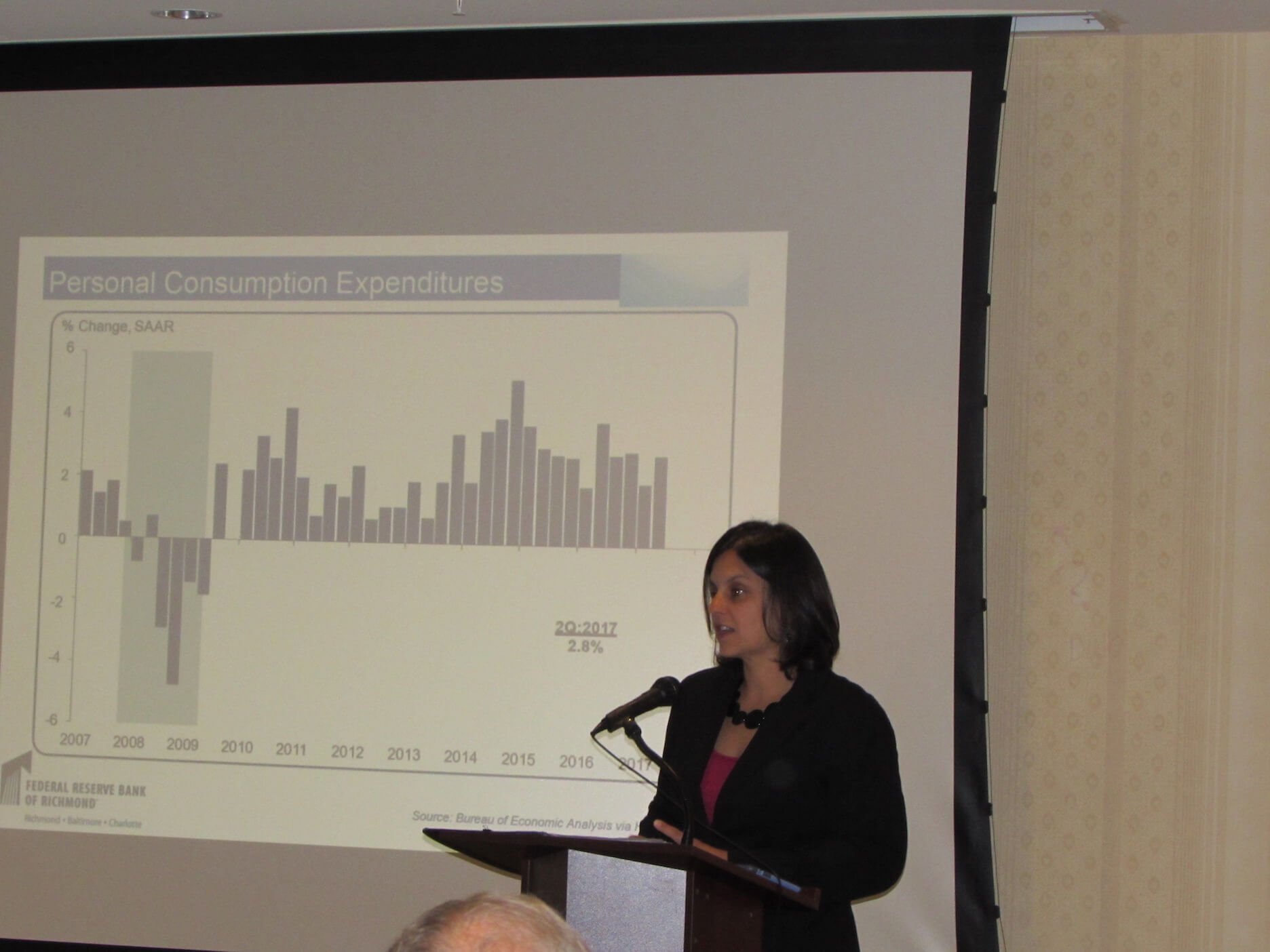Lisa Bass
Contributing writer

Sonya Ravindrannath-Waddell of the Federal Bank of Richmond spoke at the Montgomery County Chamber of Commerce’s monthly Eggs and issues series about the state of the economy at the local, state and federal levels.
The Montgomery County Chamber of Commerce held its August Eggs and Issues at Blacksburg’s Hilton Garden Inn last Thursday.
The breakfast event was sponsored by Uncork-It Inc. and Eileen Bauman introduced a speaker from the Federal Bank of Richmond, a part of the Federal Reserve System. Sonya Ravindrannath-Waddell provided an in-depth examination of the economic conditions on federal, state and regional levels.
Waddell used Federal Reserve data and provided explanations and interpretations to a packed audience of chamber members. Waddell emphasized that her opinions were not an official representation of the Federal Reserve Bank of Richmond nor the Federal Reserve System.
“Since the 2008 collapse, the last ten years have been interesting,” said Waddell. The United States Domestic Product is up 2.6 percent in the second quarter of 2017 when compared with a 2.6 percent growth over the entire 2015. Having a two percent growth is slow and steady.
Improvements in personal consumption and business investments have been strong since 2015. Exports have grown in spite of a stronger dollar, in some part due to our reduced energy costs. Governments have spent less.
Personal Consumption Expenditures (PCE) are two-thirds of the economic picture. In the last three months, retail sales have slowed down from April’s 4.1 percent to June’s 2.8 percent annual growth rate.
“Spending has flattened a bit but it still positive,” Waddell said.
Auto sales are also down, but Waddell assured chamber members that there is context or stories to the data. In the Fifth Federal District, which includes Virginia, North Carolina, South Carolina, Maryland and all but four counties in West Virginia, auto retailers are reporting through surveys that sales are indeed down from the rapid growth seen in December of 2016, but there were prediction of this downturn.
PCE affects employment growth, which has had a slow and steady improvement. June 2017 had more than 222,000 jobs filled nationwide. There is confidence with unemployment down and the observation of increased changes in jobs i.e. labor turnover.
Wages have been the most challenging. Since the recession, wages for the lower income were hardest hit. However, the average hourly rate is improving with June 2017 showing a 2.5 percent increase. Stories from industries indicate pressure to find skilled workers, which increases salary offers.
Another area of PCE is housing. Single family existing and new construction is above 1990 levels again and still trending upward. There is a lack of construction requests due to the lack of supply of buildable lots and the complications with hiring a workforce in the construction trades. Demographics dictate the demands for single versus multi-family dwellings. Millennials are waiting later to start families and they seem content with renting later into life.
Fixed investments are business expenditures in machinery commercial space. Virginia had a 5.2 percent increase in the second quarter of 2017 in transportation equipment, industrial equipment and intellectual property. Regionally in the Montgomery, Radford and Pulaski areas, manufacturing has been in line with national levels, with March and April 2017 as the strongest. Manufacturers’ common story is the shortage of qualified skilled workers.
The service industry is more positive in growth and outlook, but has the same issue of finding workers with needed skill sets.
The Blacksburg region showed a 2.1 percent job growth rate. When compared to other Virginia regions, this region was second only to Charlottesville, and surpassed Harrisonburg and Richmond as well as the U.S. national level of job growth.
As of June 2017, Virginia’s top industries and employers were professional business services and government jobs. Professional business service employed 18.3 percent of Virginia residents while nationally these industries employed 14 percent of U.S. citizens. Government jobs accounted for 18.2 percent of Virginia’s workforce, compared to 15.4 percent nationally. The strongest wages are in the professional business services.
Losses of jobs since the recession have been seen in construction, manufacturing, transportation and utilities. Manufacturing includes mining which have been hit the worst and are slow to improve like the construction trades. Transportation and utility industries are coming back stronger. May 2017 had only a 4.1 percent unemployment rate.
During the question and answer period of the Chamber’s monthly meeting, a member asked when the next downturn could be expected.
“A recession is caused by some economic catastrophe with, historically, recovery lasting five years, Waddell said. “We are into our seventh year of recovery now, with a lot of economic structural changes helping this recovery. Data doesn’t show anything about to happen. There is a lot of optimism out there.”
For more information on the chamber and its events, visit www.montgomerycc.org.



